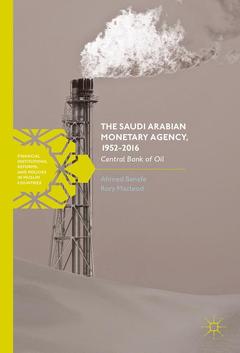The Saudi Arabian Monetary Agency, 1952-2016, Softcover reprint of the original 1st ed. 2017 Central Bank of Oil Financial Institutions, Reforms, and Policies in Muslim Countries Series
Langue : Anglais
Auteurs : Banafe Ahmed, Macleod Rory

This book sheds new light on the critical importance of the Saudi Arabian Monetary Agency (SAMA), a remarkably successful central bank that is a model for developing oil exporters worldwide. As a "swing producer", Saudi Arabia has traditionally stepped in to make up for oil supply shortfalls in other OPEC countries, or to scale back their own production when overabundance might lead to a price crash. Since 2014, Saudi Arabia has changed its policy in response to the rise of American shale oil, in search of a long-term strategy that will, once again, help balance supply and demand at a steady price. In its informal dual role of central bank and sovereign wealth fund, SAMA must navigate the paradoxes faced by monoline oil producing countries: the need for diversification vs. dependence on oil-based revenue; the loss of foreign exchange reserves that follows oil-financed government spending; the unreliability of revenue from oil; the challenges of using a Western model for supervising Shariah-compliant banks; and the need to have a balancing mix of oil and financial assets. As SAMA (now the Saudi Arabian Monetary Authority) reassesses its role in 2017, this history and guide to current policy issues will prove invaluable for policymakers in oil producing economies looking to apply lessons from the past as they plan for the future.
1. Background to Saudi Arabia’s Financial Challenges.- 2. Discovery of Oil and the Founding of the Saudi Arabian Monetary Agency 1902-52 .- 3. Financial Development Before the First Oil Crisis 1953-74.- 4. Petrodollar Recycling and Saudization of the Banking System 1975-82.- 5. Declining Foreign Exchange Reserves and Iraq’s Invasion of Kuwait 1983-93.- 6. Low Oil Prices, Rising Government Debt, and External Crises 1994-2004.- 7. Impact of the Global Financial Crisis and Its Aftermath 2005-16.- 8. The Future of Gulf Monetary Union.- 9. Foreign Exchange Reserves Management – SAMA’s Experience.- 10. Developing the Domestic Bond Markets.- 11. Currency Regime and Monetary Policy.- 12. SAMA and the International Monetary System.- 13. The Saudi Banking System.- 14. SAMA and the Future.
Ahmed Banafe is a Senior Investment Advisor at SAMA, with a career spanning forty-four years. He is the author of Saudi Arabian Financial Markets (1993) and several Bank for International Settlements papers.
Offers the authors’ insider perspectives on one of the most successful banks in any developing country Proposes a framework for understanding the Saudi Arabian economy Provides insight on SAMA’s past and current issues as it looks toward the future
Date de parution : 07-2017
Ouvrage de 330 p.
14.8x21 cm
Date de parution : 08-2018
Ouvrage de 330 p.
14.8x21 cm
Thèmes de The Saudi Arabian Monetary Agency, 1952-2016 :
© 2024 LAVOISIER S.A.S.



